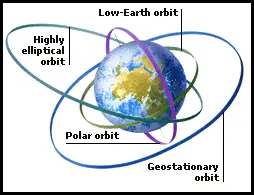 A geostationary orbit occurs when an object (satellite) is placed approximately 37,000 km (23,000 mi) above the Earth’s equator with the characteristic that, from a fixed observation point on the Earth’s surface, it appears motionless. A satellite is in an inclined orbit when its orbital plane is tipped some number of degrees from the horizontal defined by the equator. In the case of an inclined geosynchronous orbit, although the satellite remains geosynchronous (that is, completing one orbit around the earth every 24 hours), it is no longer geostationary. From a fixed observation point on Earth, it would appear to trace out a small ellipse as the gravitational effects of other stellar bodies (Sun and Moon) exhibit influence over the satellite, as the effect accumulates over time the trace becomes an analemma with lobes oriented north-southward. The satellite traces the same analemma once each sidereal day. [1]
A geostationary orbit occurs when an object (satellite) is placed approximately 37,000 km (23,000 mi) above the Earth’s equator with the characteristic that, from a fixed observation point on the Earth’s surface, it appears motionless. A satellite is in an inclined orbit when its orbital plane is tipped some number of degrees from the horizontal defined by the equator. In the case of an inclined geosynchronous orbit, although the satellite remains geosynchronous (that is, completing one orbit around the earth every 24 hours), it is no longer geostationary. From a fixed observation point on Earth, it would appear to trace out a small ellipse as the gravitational effects of other stellar bodies (Sun and Moon) exhibit influence over the satellite, as the effect accumulates over time the trace becomes an analemma with lobes oriented north-southward. The satellite traces the same analemma once each sidereal day. [1]
A geostationary orbit is not stable. It takes regular maneuvers to actively counteract the above gravitational forces. The majority of the fuel of the satellite, typically hydrazine, is spent for this purpose. Otherwise, the satellite experiences a change in the inclination over time. At the end of the satellite’s lifetime, when fuel approaches depletion, satellite operators may decide to omit these expensive maneuvers to correct inclination and only control eccentricity. This prolongs the life-time of the satellite as it consumes less fuel over time, but the satellite can then only be used by ground antennas capable of following the north-south movement, Satellite Tracking earth stations. Before the fuel comes to an end, satellites can be moved to a graveyard orbit to keep the geostationary altitude free for subsequent missions. [1]
NASA maintains a Java based real-time display of most commercial satellites which can be helpful in visualizing the various orbits. [1]
AcqLinks and References:
- [1] Website: Wikipedia – Inclined Orbits
